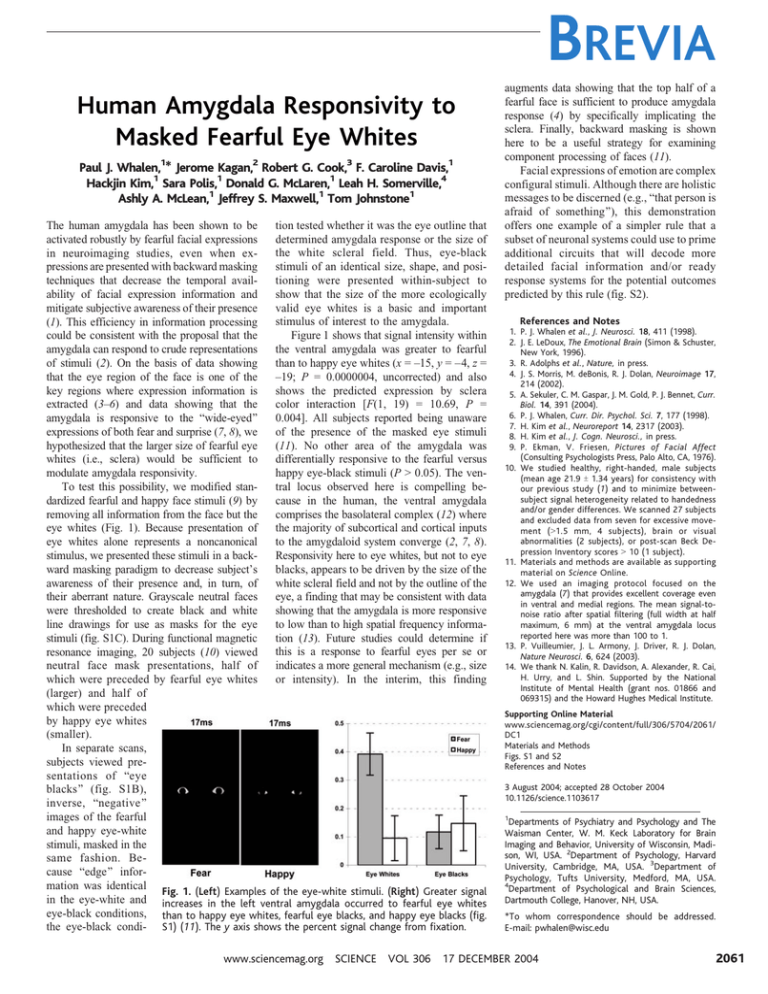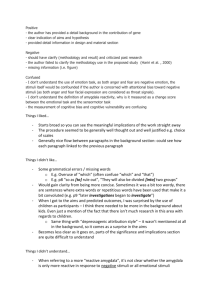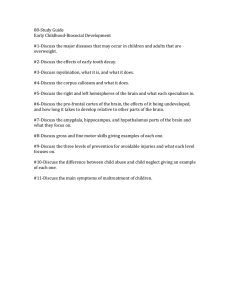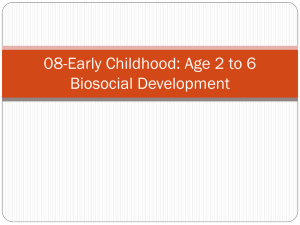Human Amygdala - Dartmouth College
advertisement

BREVIA Human Amygdala Responsivity to Masked Fearful Eye Whites Paul J. Whalen,1* Jerome Kagan,2 Robert G. Cook,3 F. Caroline Davis,1 Hackjin Kim,1 Sara Polis,1 Donald G. McLaren,1 Leah H. Somerville,4 Ashly A. McLean,1 Jeffrey S. Maxwell,1 Tom Johnstone1 tion tested whether it was the eye outline that The human amygdala has been shown to be determined amygdala response or the size of activated robustly by fearful facial expressions the white scleral field. Thus, eye-black in neuroimaging studies, even when exstimuli of an identical size, shape, and posipressions are presented with backward masking tioning were presented within-subject to techniques that decrease the temporal availshow that the size of the more ecologically ability of facial expression information and valid eye whites is a basic and important mitigate subjective awareness of their presence stimulus of interest to the amygdala. (1). This efficiency in information processing Figure 1 shows that signal intensity within could be consistent with the proposal that the the ventral amygdala was greater to fearful amygdala can respond to crude representations than to happy eye whites (x 0 –15, y 0 –4, z 0 of stimuli (2). On the basis of data showing –19; P 0 0.0000004, uncorrected) and also that the eye region of the face is one of the shows the predicted expression by sclera key regions where expression information is color interaction EF(1, 19) 0 10.69, P 0 extracted (3–6) and data showing that the 0.004^. All subjects reported being unaware amygdala is responsive to the Bwide-eyed[ of the presence of the masked eye stimuli expressions of both fear and surprise (7, 8), we (11). No other area of the amygdala was hypothesized that the larger size of fearful eye differentially responsive to the fearful versus whites (i.e., sclera) would be sufficient to happy eye-black stimuli (P 9 0.05). The venmodulate amygdala responsivity. tral locus observed here is compelling beTo test this possibility, we modified stancause in the human, the ventral amygdala dardized fearful and happy face stimuli (9) by comprises the basolateral complex (12) where removing all information from the face but the the majority of subcortical and cortical inputs eye whites (Fig. 1). Because presentation of to the amygdaloid system converge (2, 7, 8). eye whites alone represents a noncanonical Responsivity here to eye whites, but not to eye stimulus, we presented these stimuli in a backblacks, appears to be driven by the size of the ward masking paradigm to decrease subject_s white scleral field and not by the outline of the awareness of their presence and, in turn, of eye, a finding that may be consistent with data their aberrant nature. Grayscale neutral faces showing that the amygdala is more responsive were thresholded to create black and white to low than to high spatial frequency informaline drawings for use as masks for the eye tion (13). Future studies could determine if stimuli (fig. S1C). During functional magnetic this is a response to fearful eyes per se or resonance imaging, 20 subjects (10) viewed indicates a more general mechanism (e.g., size neutral face mask presentations, half of or intensity). In the interim, this finding which were preceded by fearful eye whites (larger) and half of which were preceded by happy eye whites (smaller). In separate scans, subjects viewed presentations of Beye blacks[ (fig. S1B), inverse, Bnegative[ images of the fearful and happy eye-white stimuli, masked in the same fashion. Because Bedge[ information was identical Fig. 1. (Left) Examples of the eye-white stimuli. (Right) Greater signal in the eye-white and increases in the left ventral amygdala occurred to fearful eye whites eye-black conditions, than to happy eye whites, fearful eye blacks, and happy eye blacks (fig. the eye-black condi- S1) (11). The y axis shows the percent signal change from fixation. www.sciencemag.org SCIENCE VOL 306 augments data showing that the top half of a fearful face is sufficient to produce amygdala response (4) by specifically implicating the sclera. Finally, backward masking is shown here to be a useful strategy for examining component processing of faces (11). Facial expressions of emotion are complex configural stimuli. Although there are holistic messages to be discerned (e.g., Bthat person is afraid of something[), this demonstration offers one example of a simpler rule that a subset of neuronal systems could use to prime additional circuits that will decode more detailed facial information and/or ready response systems for the potential outcomes predicted by this rule (fig. S2). References and Notes 1. P. J. Whalen et al., J. Neurosci. 18, 411 (1998). 2. J. E. LeDoux, The Emotional Brain (Simon & Schuster, New York, 1996). 3. R. Adolphs et al., Nature, in press. 4. J. S. Morris, M. deBonis, R. J. Dolan, Neuroimage 17, 214 (2002). 5. A. Sekuler, C. M. Gaspar, J. M. Gold, P. J. Bennet, Curr. Biol. 14, 391 (2004). 6. P. J. Whalen, Curr. Dir. Psychol. Sci. 7, 177 (1998). 7. H. Kim et al., Neuroreport 14, 2317 (2003). 8. H. Kim et al., J. Cogn. Neurosci., in press. 9. P. Ekman, V. Friesen, Pictures of Facial Affect (Consulting Psychologists Press, Palo Alto, CA, 1976). 10. We studied healthy, right-handed, male subjects (mean age 21.9 T 1.34 years) for consistency with our previous study (1) and to minimize betweensubject signal heterogeneity related to handedness and/or gender differences. We scanned 27 subjects and excluded data from seven for excessive movement (91.5 mm, 4 subjects), brain or visual abnormalities (2 subjects), or post-scan Beck Depression Inventory scores 9 10 (1 subject). 11. Materials and methods are available as supporting material on Science Online. 12. We used an imaging protocol focused on the amygdala (7) that provides excellent coverage even in ventral and medial regions. The mean signal-tonoise ratio after spatial filtering (full width at half maximum, 6 mm) at the ventral amygdala locus reported here was more than 100 to 1. 13. P. Vuilleumier, J. L. Armony, J. Driver, R. J. Dolan, Nature Neurosci. 6, 624 (2003). 14. We thank N. Kalin, R. Davidson, A. Alexander, R. Cai, H. Urry, and L. Shin. Supported by the National Institute of Mental Health (grant nos. 01866 and 069315) and the Howard Hughes Medical Institute. Supporting Online Material www.sciencemag.org/cgi/content/full/306/5704/2061/ DC1 Materials and Methods Figs. S1 and S2 References and Notes 3 August 2004; accepted 28 October 2004 10.1126/science.1103617 1 Departments of Psychiatry and Psychology and The Waisman Center, W. M. Keck Laboratory for Brain Imaging and Behavior, University of Wisconsin, Madison, WI, USA. 2Department of Psychology, Harvard University, Cambridge, MA, USA. 3Department of Psychology, Tufts University, Medford, MA, USA. 4 Department of Psychological and Brain Sciences, Dartmouth College, Hanover, NH, USA. *To whom correspondence should be addressed. E-mail: pwhalen@wisc.edu 17 DECEMBER 2004 2061




